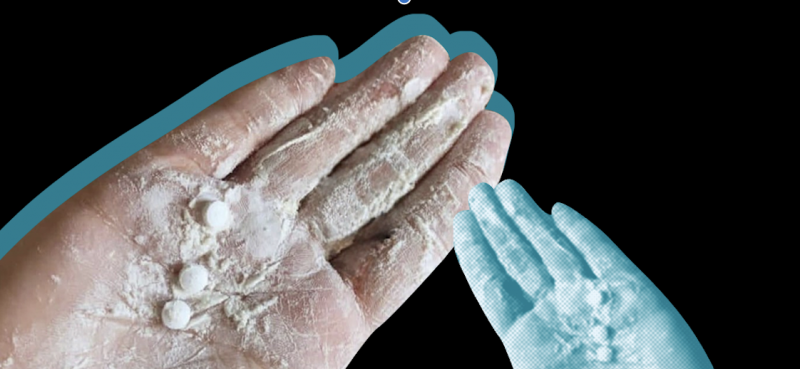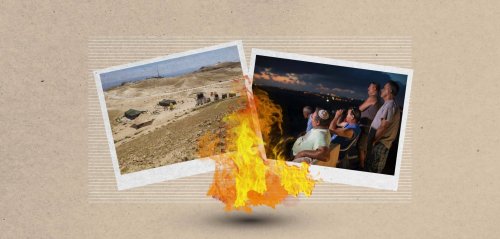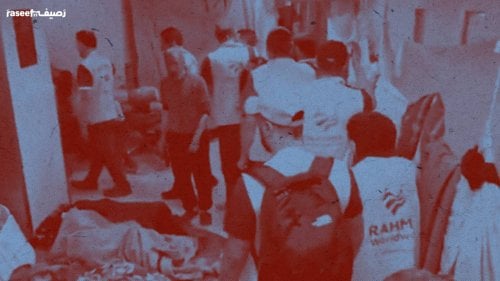On June 27th, Gaza’s Government Media Office sounded the alarm, announcing the discovery of oxycodone tablets inside flour sacks distributed through the “aid” centers operated by the occupation army—centers that Gaza’s residents now refer to as death traps.
This finding does not signify a random tragedy; it indicates a deliberate calculation by the Israeli authorities to cultivate mass addiction in Gaza, adding chemical terror to the arsenal of genocide that already includes killing, destruction, siege, starvation, and the spread of disease.
When a highly potent opioid such as oxycodone is introduced into Gaza’s traumatized society, the social equation moves from despair to catastrophe. Addiction is no longer an individual tragedy but a multiplier of hunger, unemployment, violence, and suicide. Its effects may also outlast any ceasefire or reconstruction plan. The 21st century is currently witnessing the world’s last remaining settler colony, Israel, inscribing itself in this colonial tradition: it has imposed a hermetic blockade on Gaza, fired on civilians queuing for food, and laced relief flour with a highly addictive opioid. What gunboats achieved in Canton and crackdowns wrought in Bogotá, oxycodone may today accomplish in Gaza.
What is oxycodone?
Oxycodone is a semi-synthetic opioid, twice as potent as morphine, binding receptors in the brain and spinal cord. Within minutes of ingestion, it unleashes a surge of dopamine-driven euphoria, reduces pain perception, and slows breathing. Repeated doses remodel the brain’s reward circuits so that the drug’s absence itself triggers severe withdrawal pain. Tolerance escalates quickly, pushing users toward higher doses or toward crushing and snorting the tablets in pursuit of the initial rush. Physicians generally prescribe oxycodone only for the most severe pain, such as that following major surgery or associated with cancer.
When a highly potent opioid such as oxycodone is introduced into Gaza’s traumatized society, the social equation moves from despair to catastrophe. Addiction is no longer an individual tragedy but a multiplier of hunger, unemployment, violence, and suicide. Its effects may also outlast any ceasefire or reconstruction plan.
Oxycodone first rose to prominence in the United States, where it triggered an ongoing opioid crisis. Purdue Pharma launched OxyContin in 1996 with an aggressive marketing campaign that drove annual sales from $48 million to $1.1 billion in just four years while reassuring physicians that addiction was “rare.” Three successive waves of opioid-related deaths followed: prescription opioids in the late 1990s, heroin in the next decade, and illicit fentanyl after 2013. Roughly 727,000 Americans died of opioid overdoses between 1999 and 2022 (nearly one-third of Gaza’s population), and opioids were responsible for 76% of the 108,000 overdose deaths recorded in 2022.
Purdue Pharma filed for bankruptcy in 2019 after facing thousands of lawsuits over its role in the opioid epidemic, in an attempt to shield itself from paying further damages. Bankruptcy proceedings are still ongoing, and the latest settlement paid by the company and its owners, the Sackler family, amounted to $7.4 billion in early 2025.
Opioids’ neural hooks unleash a chain of cumulative social harms. Families lose their breadwinners to compulsive use, care for children and older people collapse, and rates of petty theft and prostitution rise in order to fund addiction. In the United States, counties in the so-called “opioid belt” during the early 2000s experienced decreased labor force participation, ballooning child-welfare caseloads, and municipal budgets skewed toward policing and emergency services, effects that Gaza’s devastated social fabric is in no position to bear.
Drugs as weapons of war
The use of narcotics as a weapon is neither marginal nor merely theoretical; it is a recurring theme whenever powerful states seek non-conventional means to subjugate populations. In 2002, Freedom of Information Act requests uncovered Pentagon documents praising aerosolized benzodiazepine (a sedative akin to Valium) as a tool for crowd control and counter-terrorism. The papers discussed the cutoff doses that might evade breaching the Chemical Weapons Convention since only a thin line separates a calming effect from respiratory arrest. The Sunshine Project, which disclosed the documents, warned that any field deployment of benzodiazepine would constitute covert chemical warfare.
Russian authorities crossed the line separating sedation from killing during the Moscow theater hostage crisis. On October 26th, 2002, special forces pumped an opioid-laden mist through the Dubrovka Theater’s ventilation system. The opioids were later identified as a mixture of carfentanil and remifentanil, thousands of times stronger than morphine. The gas rendered the forty Chechen hostage takers unconscious, but it also killed 132 of the 912 hostages and left hundreds suffering from chronic respiratory damage.
The use of narcotics as a weapon is neither marginal nor merely theoretical; it is a recurring theme whenever powerful states seek non-conventional means to subjugate populations.
The most infamous case, however, remains the CIA’s Project MK-ULTRA (1953-1973). Operating under that codename, agency personnel secretly administered LSD, barbiturates, and mescaline to prisoners, psychiatric patients, students, and even other CIA colleagues, in search of developing mind-control techniques and “truth serums.” Senate hearings in 1975 revealed dozens of sub-projects and at least one confirmed death: the toxicologist Frank Olson, who fell from a hotel window after being surreptitiously dosed with LSD. The scandal prompted a rewriting of US research ethics regulations and became a classic illustration of how easily individual autonomy can be violated in the name of “national security.”
From tranquilizers to opioids and hallucinogens, these examples share a common theme: presenting chemical addiction or neural paralysis as an alternative to bullets, only to yield lethal consequences and slip into legal grey zones. The distribution of flour laced with oxycodone in Gaza is therefore no novel Israeli invention; it is the latest extension of a historically documented narcotics war arsenal that replaces the spectacle of explosions with the insidious collapse brought on by addiction and social disintegration.
Israel’s weaponization of addiction
Gaza was already poised on the edge of an addiction crisis even before the first flour sack laced with oxycodone was opened. The 2021 World Drug Report issued by the United Nations Office on Drugs and Crime warned of a sharp and prolonged rise in the non-medical use of prescription medicines in the occupied Palestinian territory, noting that between 1995 and 2019, pills, rather than plant-based drugs, became the fastest-growing segment of the local narcotics market.
Addiction is known to be associated with psychological disorders, which are exacerbated by the occupation. A 2024–2025 study of internally displaced families in Gaza recorded alarming rates: 99.5% of adults suffered from depression, 99.7% from anxiety, and 93.7% from clinically significant stress. In a context where mental illness is almost universal, introducing narcotics brings fire to kindling.
The report that Israeli authorities had laced flour with oxycodone is not the first to link the regime to the use of drugs as a weapon of war. Israel’s record is laden with covert and overt operations centered on narcotics.
An Israeli investigative report published in 2020 exposed “Operation Addictive Candy,” a secret project run by Unit 504 of the Military Intelligence Directorate during the late 1970s and 1980s. The project capitalized on the booming hashish and opium trade in South Lebanon, diverting smuggling routes and illicit cash flows into clandestine channels for handling agents, moving intelligence, and financing off-budget operations.
With no internal oversight, some Israeli officers profited from the illicit trade. When the scandal threatened to surface, the army imposed gag orders, sealed indictments, and even confined one key actor to a psychiatric hospital, effectively burying the affair among the darkest chapters of Israeli intelligence.
This pattern was plain in early 2017, when Ahmed Kidra, Head of Gaza’s anti-drug unit, reported that the hashish, tramadol tablets, and MDMA pills seized in January 2017 alone matched the total amount seized the entire previous year. He accused Israel of a deliberate strategy to “flood Gaza with drugs,” noting that border inspectors routinely ignored smuggling consignments hidden inside commercial cargo. Independent field research has echoed this charge: Israel and Egypt were the main sources of the pills flowing into the Strip, with the aim of weakening Gaza’s society from within.
The distribution of flour laced with oxycodone in Gaza is therefore no novel Israeli invention; it is the latest extension of a historically documented narcotics war arsenal that replaces the spectacle of explosions with the insidious collapse brought on by addiction and social disintegration.
Israeli officials swiftly denied the allegations, citing Hamas propaganda. Yet the defense does not hold water: if the blockade is tight enough to ration cancer medicine and infant formula, it is equally tight enough to block narcotics. The selective permeability that lets drugs through while keeping cement, books, and surgical sutures on the prohibited list betrays deliberate policy rather than accident.
Another chapter in a long colonial tradition
Israel has tightened its blockade of Gaza by land, sea, and air for seventeen years, inspecting every commercial lorry, fishing boat, and medicine shipment. The International Committee of the Red Cross regards this level of “effective control” as occupation, which obliges the occupying power to safeguard public health and “facilitate the passage of humanitarian aid.” In practice, the blockade chokes legitimate imports while narcotics slip through in volumes local police cannot anticipate or contain.
Israel cannot claim the privileges of the gatekeeper at Gaza’s crossings while rejecting the consequences that come with acting as a trafficker. By controlling the enclave’s borders, it assumes responsibility for everything that crosses them. Every pill that slides past a checkpoint, every oxycodone tablet discovered in a sack of flour, is therefore not simply contraband but evidence of state policy that weaponizes addiction against a captive civilian population.
Drugging a besieged population to sap its resistance is not an aberration of the 21st century. It is the revival of an age-old imperial tradition. In the 19th century, Britain forced Indian opium on China to pry open its markets and tear its social fabric. In the 20th century, Washington declared a “global war on drugs,” criminalizing the very substances its intelligence services had exploited, and exporting chaos abroad while cloaked in an air of moral superiority.
By controlling Gaza's borders, it assumes responsibility for everything that crosses them. Every pill that slides past a checkpoint, every oxycodone tablet discovered in a sack of flour, is therefore not simply contraband but evidence of state policy that weaponizes addiction against a captive civilian population.
This is but another strategy of genocide by slow attrition. Each pill swallowed under siege erodes the social compact that has kept Gaza alive for seventeen years. This episode offers one more glaring example of why a party accused of genocide cannot be entrusted with distributing aid to the community it seeks to destroy. The world may again doubt Gazans who say their flour is laced with narcotics, yet our humanity is tested by whether we choose to believe them now rather than acknowledge the truth retrospectively when it’s too late — after the harm has already been done.
Editor's note: This article was originally published in Arabic for Al Sifr Magazine.
Raseef22 is a not for profit entity. Our focus is on quality journalism. Every contribution to the NasRaseef membership goes directly towards journalism production. We stand independent, not accepting corporate sponsorships, sponsored content or political funding.
Support our mission to keep Raseef22 available to all readers by clicking here!
Interested in writing with us? Check our pitch process here!







